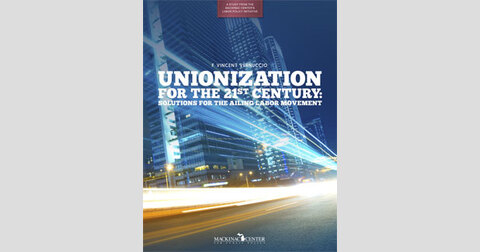Recommendations to Improve the Labor Movement
For years union membership has been in decline. In 2012 union membership hit the lowest percentage of the American workforce since 1916.
The union business model, based on industrial organizing of the 1930s, does not translate well in today’s educated workforce.
Unfortunately unions have not adapted to this modern shift in work demographics.
The new Mackinac study "Unionization for the 21st Century" proposes a way forward for the labor movement.
This study recommends several ways to improve labor organizations by making them more responsive, refocusing their efforts to be more like professional associations which at their core are about services and representation.
In order to thrive, unions must move away from the coercive nature, monopolies, and privileges that were given to them by the labor laws of the last century. The way for unions to grow again is by allowing them to enter the free market and compete for the hard earned voluntary dues of their future members.
Central to this idea is allowing unions to vie for members and only represent those members who wanted to be represented. These unions should cater to the skilled individual worker of the 21st century and not impose an outdated one size fits all model on them.
In many cases, even the choice of representation could go further. Instead of simply giving a worker a take-it-or-leave-it proposal, unions could specialize in à la carte services where their members could pick and choose what they wanted from one or multiple unions.
The four areas which the study recommends 21st century unions can thrive are:
- Professional organizations – Unions should act as the American Bar Association or other professional associations. They should advocate for their members’ interests in the industry, serve as a resource for collaboration and provide social networking events.
- Unions as representatives – Unions must realize that employees are unique. They should refocus on providing resources for individual contracts and employees should be allowed to negotiate for themselves. Merit pay clauses and rewards for productivity should be embraced.
- Unions as insurance – Unions can provide malpractice insurance and other optional life, health and retirement benefits, such as defined-contribution plans, which workers can take with them from job to job and union to union.
- Unions as trainers and voluntary certification agencies – Unions should continue to provide training and apprenticeship programs (free of taxpayer dollars.)
Michigan Capitol Confidential is the news source produced by the Mackinac Center for Public Policy. Michigan Capitol Confidential reports with a free-market news perspective.


Jobs agency ghost-writes its own public relations